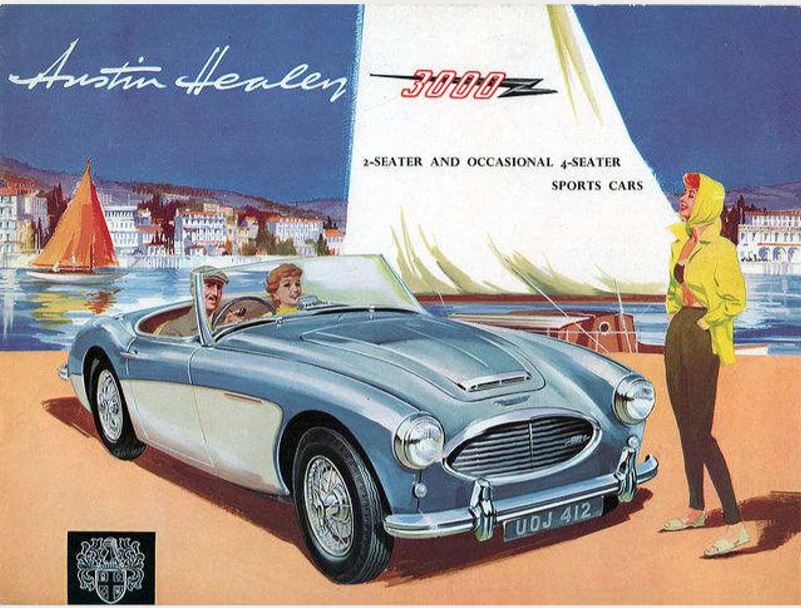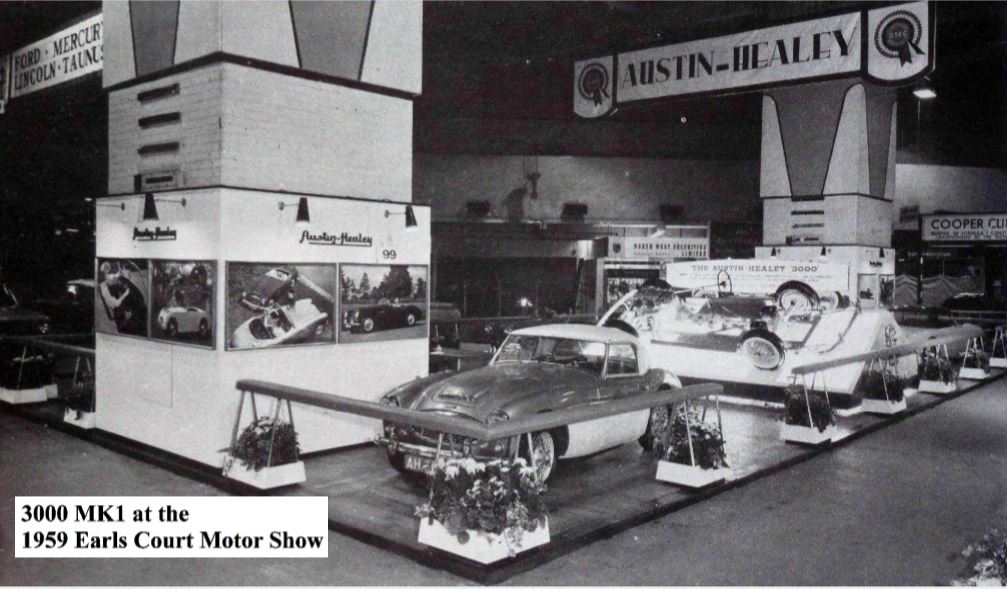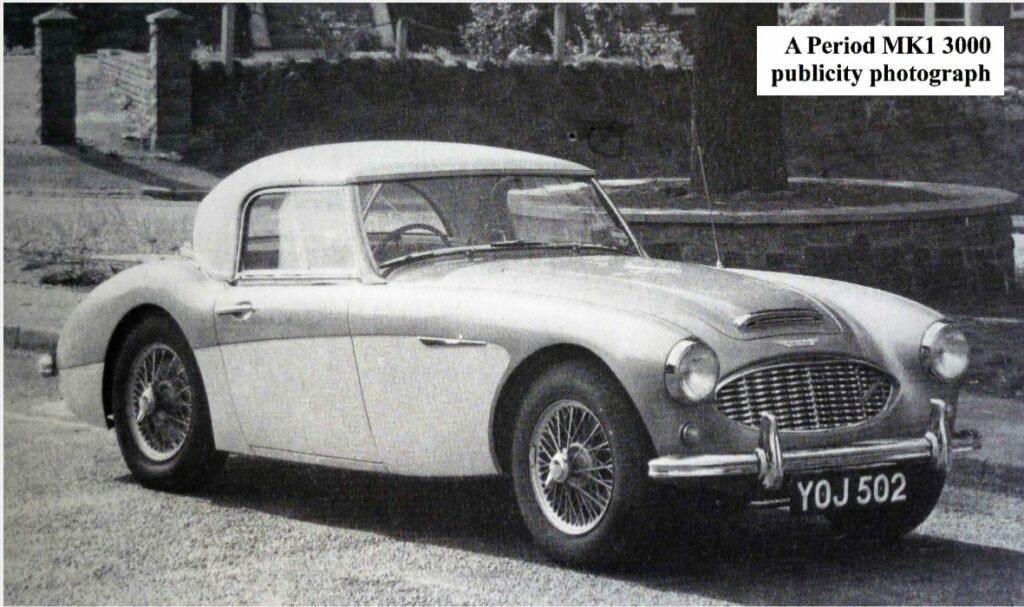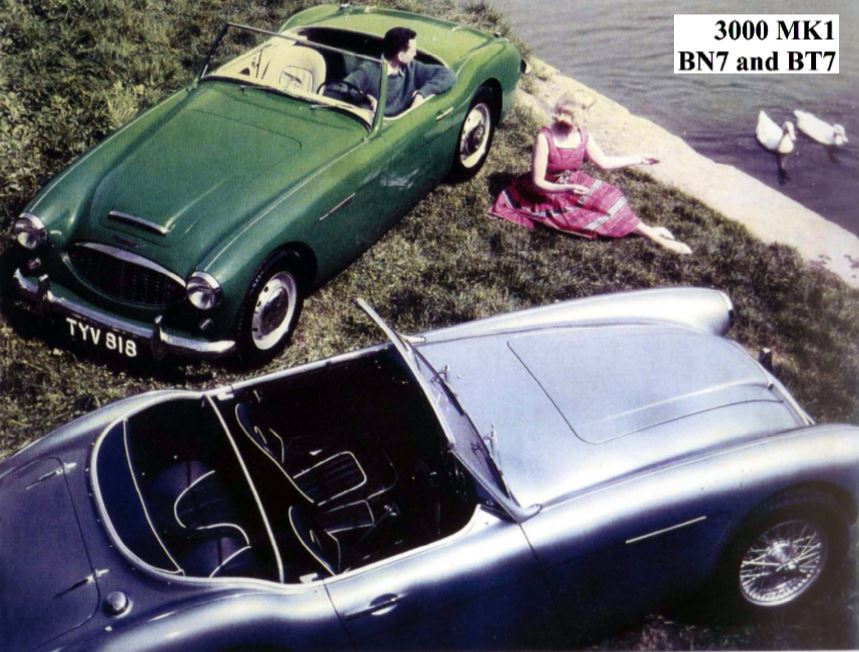60 Years of the Austin Healey 3000
Throughout the world the Austin Healey 3000 is recognised as one of the most iconic of British sports cars, and 2019 will see the 60th anniversary of the launch of the model.
To acknowledge this milestone, I thought it might be interesting to look back at how this vehicle came to be produced and the changes that took place both during and since its introduction.
We all know that Donald Healey set out after WW2 to manufacture his own motor car, and in Warwick he successfully produced a variety of ‘Healey’ models based around Riley components.These were expensive high quality cars of limited production, but some were exported to the USA, where Donald was exposed to what Americans expected in the way of a sports car. In 1949 he returned to the States and met the president of Nash Motors, where an agreement was reached to manufacture the Nash Healey. The steady production of this car enabled the Donald Healey Motor Co. to generate funds and to understand the exact requirements of the American market.
By 1951 the Jaguar XK120 was a serious, but expensive, contender in the sports car market, and Donald was convinced that a medium priced highperformance sports 2-seater had export potential. He had a design in mind but by this time the continuing supply of Riley parts was in doubt, so he approached Austin for similar components including their A90 4cylinder 2,660cc engine. Following chassis and body design by Barry Bilbie and Gerry Coker the first ‘Healey Hundred’ was born.

Following development, road testing in Belgium recorded a top speed of 111 mph, and the car was prepared for the publicity of the 1952 International Motor Show, at Earls Court, London. As is widely known, the car was the star attraction, and Len Lord proposed that Austin should manufacture the car in quantity, and so virtually overnight it became the ‘Austin Healey 100’, model BN1.
By 1955 production of the Austin A90 engine was coming to an end and BMC wanted to utilise its 6cylinder 2,639cc engine. This would still fit the engine bay, but as a shorter prop shaft was required the engine was more difficult to install. Because of this and Donald’s insistence that to widen its sales appeal the car should be available as a 4seater, the decision was made to extend the wheelbase and body length whilst retaining the overall ‘Hundred’ styling. Designated the ‘Austin Healey 100 Six’ (4seater BN4), production of the new model began at Longbridge in March 1956 and was accompanied by several body changes. The windscreen was now fixed, the bonnet had a central air intake to clear the front of the longer engine, and the radiator grille was restyled to utilise Austin’s stock item, as were the bumpers. Shortly afterwards the decision was taken to move production to MG Cars at Abingdon and they rolled of the line here from November 1957.
With Donald and Geoff Healey’s involvement in racing the ‘Morris Engines’ division of BMC produced 3 special engines with new 6-port cylinder heads, which were far more efficient than the original 4-port variety. These provided almost 20% more power and were eventually fitted to the production cars. In 1958, utilising this more powerful engine Abingdon began production of the 2seater BN6 alongside the BN4. BMC’s entry into rallying around this time meant there was a continual call for more torque and power, and so Morris Engines developed a new strengthened engine block and increased the bore diameter to produce an engine of 2,993cc. The 3-litre engine had arrived with a power output of 124bhp.
Production of the ‘100 Six’ ended in March 1959, by which time almost 30,000 Austin Healey’s of all models had been manufactured, 93% of which had been exported, with 65% going to North America alone.

The ‘Austin Healey 3000’ was officially announced on 1st July 1959 (2-seater BN7, 4-seater BT7) and was visually almost identical to the ‘100 Six’, but came with the new 3 litre engine, revised gear ratios, stronger gears and disc brakes on the front. The car was launched into a rapidly changing post-war society with the ‘Swinging-Sixties’ just around the corner. In 1959, for those whose memories of that era are hazy, Harold Macmillan as Prime Minister told the nation ‘You’ve never had it so good’, the first section of the M1 opened, the Austin Seven (Mini) was announced, Mike Hawthorn lost his life in his Jaguar 3.4 on the Guildford bypass, and the revolutionary Hovercraft took to the water.
Across the globe there were similar milestones. Richard Nixon was President in the USA, Fidel Castro came to power in Cuba, and the Dalai Lama was forced to flee Tibet. The US motor manufacturers Hudson and Nash joined forces to become AMC (American Motors), the first Boeing 707 came into service, the US launched the first weather station, NASA introduced the first Astronauts to the world, and ‘Barbie’ went on sale! The latest TV offerings from the US that year included Rawhide, Bonanza and The Twilight Zone, with ‘Ben Hur’ hitting the big screen, and ‘The Sound of Music’ opening on Broadway.

The Austin Healey 3000 went on sale in the UK at a price of £1175 10s 10d, in old money, of which some 30% was purchase tax. Optional extras included: Hard Top £85, Heater £21 19s 2d, Overdrive £66 8s 2d, Wire Wheels £35 8s 4d and Radio £34. Contemporary road tests quoted a mean top speed as being 108 mph, or 114 mph using overdrive, with 0-60 mph achievable in 11.4 seconds.
Production of the 3000 continued apace with some 13650 manufactured between July 1959 and May 1961, but only 829 of these went to the home market. Whilst sales were buoyant the main criticisms of the car were the lack of ground clearance, the high cockpit temperature from the exhaust, the awkward angle of the side change gear lever, and the need for an improved and simpler hood.
Because American drivers expected to see new models introduced annually a 3000 Mk2 was released in May 1961. This model had its power output raised to 132 bhp by replacing the camshaft and fitting three SU carburettors; whilst a revised grille with vertical slats ensured that the car had a more expensive appearance and was visually distinctive from its predecessor. The model designations remained unchanged as BN7 and BT7.
In March 1962 the 2-seater BN7 was discontinued and a further development of the BT7 was introduced as the BJ7, or AH 3000 Sports Convertible. The body was revised to include a wrap around windscreen with windup windows, quarter lights, a vastly improved convertible hood, and the centre-change gearbox was now in production. This was a much improved car, and maintenance was simplified by a return to twin carburettors.
February 1964 saw the BJ7 being replaced by the BJ8, 3000 Mk3 Convertible. The main improvement this time was an increase in engine power to 150 bhp, along with the fitting of a more efficient exhaust system comprising of four silencers that could meet future legislation. A brake servo now came as standard, improved heat insulation was installed and a wood veneered dashboard graced the interior.
A phase 2 version of this model was quietly introduced in May 1964 which incorporated the final planned changes that were not ready in February; these included improved ground clearance by re-profiling the rear chassis, radius arms on the rear axle, larger front brakes, and separate direction indicators.
Manufacturing continued with only minor changes until the end of 1967, although the very last ever Healey 3000 finally rolled of the line in March 1968.
Lord Stokes killed off production of the Austin Healey 3000 because of tightening safety and emission regulations in America, and the rationalisation programme of the newly formed British Leyland Motor Corporation.
Production of 3000’s at Abingdon totalled 42,926 cars over the model’s lifetime, of which a mere 2725 were for the UK market; 93% of production was exported of which some 80% went to North America.
In its final guise the big Healey sold in the UK for £1106 3s 9d, had a top speed of 122 mph and could achieve 060 mph in 9.8 seconds. It had become a fast and comfortable touring car, and fittingly 2019 will also be the 55th anniversary of the introduction of the BJ8, 3000 Mk3.
Mike Huish

